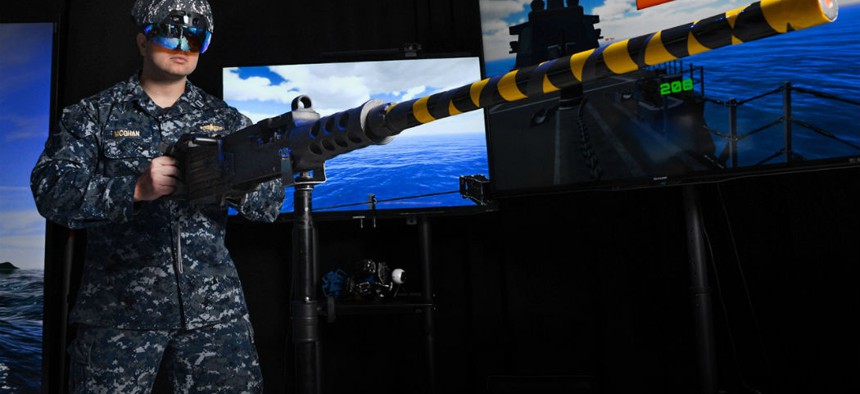The Navy tests new augmented reality helmet, automation
2017 Trident Warrior exercise will offer a chance for sailors to operate cutting edge naval warfare technology.
Preparations are underway for the 2017 Trident Warrior exercise, where sailors are exposed to the newest innovations in naval systems warfare and provide feedback on the systems to commanders and developers, according to officials at Space and Naval Warfare Systems Command (SPAWAR).
The exercise will be held in June and facilitated by U.S. Fleet Forces Command, though offices and programs across the Navy, such as SPAWAR and the Navy’s C4I program office, contribute their latest technology to be tested. Aircraft carrier USS Theodore Roosevelt (CVN 71), currently stationed off the coast of San Diego, will host the exercise.
This year, the Unified Gunnery System augmented reality helmet, known as GunnAR, will be among the new technologies being tested. According to a previous report by Defense Systems, the helmet was invented by Lt. Robert McClenning and visually synthesizes data from a ship’s weapons systems with information feeds from a ship’s gunnery liaison officer.
A GunnAR prototype was demonstrated to select groups within the Navy late last year, said Heidi Buck, Director of the Battlespace Exploitation of Mixed Reality lab. “However, at Trident Warrior 2017…we'll be demonstrating a more mature capability on… (CVN 71) USS Theodore Roosevelt,” she said.
The Trident Warrior exercise allows sailors to conduct real-time simulated operations using new hardware technology, like GunnAR helmets, but it also allows sailors to engage with the latest software and cyber technology.
The Naval Integrated Tactical–Cloud Reference for Operational Superiority (NITROS) is one piece of cyber technology that played a key a role in last year’s Trident Warrior exercise, according to a Navy press release, and may appear this year as well.
The NITROS initiative is part of the Navy’s drive to effectively process and use the vast influx of data that advanced C4ISR technology is now providing. It is designed to analyze organic and non-organic data coming in from a variety of platforms and sources, and turn it into valuable tactical information, the Navy said.
"NITROS brings the power of automation to analysts' workflows, allowing [sailors] to dedicate their time to the 'why' instead of the 'how’…NITROS represents an enterprise-wide shift toward collaborative integrated delivery of information warfare," said Dr. Bob Parker, Technical Director of the Navy’s C4I program office at the time.
The most important part of the Trident Warrior exercise is the feedback given by the sailors who operated the new technology. Comments are given anonymously so that personnel are not afraid to be honest about the experience, according to the Navy.
"Learning…-- that's huge,” said a petty officer after participating in the 2016 Trident Warrior exercise, “[Learning] what has a potential to be part of our jobs -- that's awesome."
Other technologies involved in this year’s Trident Warrior exercise will be released once the exercise takes place.
NEXT STORY: Marine Corps develops new ruggedized tablet





